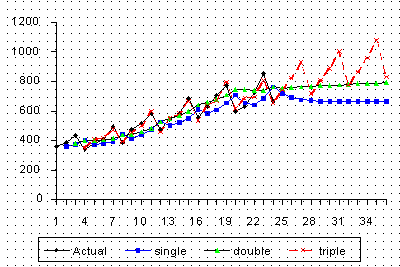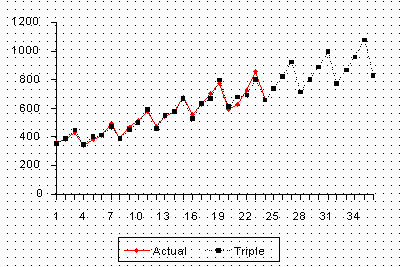6.4. Introduction to Time Series Analysis
6.4.3. What is Exponential Smoothing?
6.4.3.6. |
Example of Triple Exponential Smoothing |
The following data set represents 24 observations. These are six years of quarterly data (each year has four quarters).
| Quarter | Period | Sales | Quarter | Period | Sales | |||
|---|---|---|---|---|---|---|---|---|
|
|
||||||||
| 90 | 1 | 1 | 362 | 93 | 1 | 13 | 544 | |
| 2 | 2 | 385 | 2 | 14 | 582 | |||
| 3 | 3 | 432 | 3 | 15 | 681 | |||
| 4 | 4 | 341 | 4 | 16 | 557 | |||
| 91 | 1 | 5 | 382 | 94 | 1 | 17 | 628 | |
| 2 | 6 | 409 | 2 | 18 | 707 | |||
| 3 | 7 | 498 | 3 | 19 | 773 | |||
| 4 | 8 | 387 | 4 | 20 | 592 | |||
| 92 | 1 | 9 | 473 | 95 | 1 | 21 | 627 | |
| 2 | 10 | 513 | 2 | 22 | 725 | |||
| 3 | 11 | 582 | 3 | 23 | 854 | |||
| 4 | 12 | 474 | 4 | 24 | 661 | |||
The reader can download the data as a text file.


| MSE |
\(\alpha\)
demand |
\(\gamma\)
trend |
\(\beta\)
seasonality |
|---|---|---|---|
|
|
|||
| 6906 | 0.4694 | ||
| 5054 | 0.1086 | 1.0000 | |
| 936 | 1.0000 | 1.0000 | |
| 520 | 0.7556 | 0.0000 | 0.9837 |
The updating coefficients were chosen by a computer program such that the MSE for each of the methods was minimized.
| 1 | 2 | 3 | 4 | 5 | 6 | |
|---|---|---|---|---|---|---|
|
|
||||||
| 1 | 362 | 382 | 473 | 544 | 628 | 627 |
| 2 | 385 | 409 | 513 | 582 | 707 | 725 |
| 3 | 432 | 498 | 582 | 681 | 773 | 854 |
| 4 | 341 | 387 | 474 | 557 | 592 | 661 |
|
|
||||||
| \(\bar{X}\) | 380 | 419 | 510.5 | 591 | 675 | 716.75 |
In this example we used the full 6 years of data. Other schemes may use only 3, or some other number of years. There are also a number of ways to compute initial estimates.

